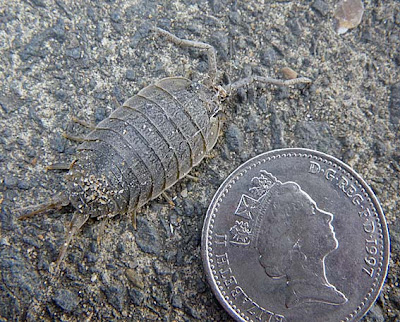Today's Guardian Country Diary describes encounters with two very interesting animals during a stroll on Roker Pier at Sunderland. Here's the pier, below, on a calm, sunny day.
This sea slater Ligia oceanica had crawled out of a crack between the stone blocks on the pier. They usually do most of their feeding at dusk, grazing on algae, and you don't often see them in the open in broad daylight. This is Britain's largest woodlouse species and it's confined to areas just above the high water mark on the seashore. The coin is a 10 pence piece, 25mm. in diameter, so you can get an idea of the animal's size - about four times larger than a garden woodlouse.
These little animals are very well camouflaged, especially when they hunker down so that the skirts of their armour plates are pressed close to the ground and they cast no shadow. It matched the stone so well that it was very lucky that I didn't tread on it.
The most remarkable thing about sea slaters is the ease and speed with which they change colour, due to being able to expand and contract pigment spots in their cuticle, so that they match their background. This is the same animal as the one on the grey stone, after it had been kept on a white background in bright sunlight for a few minutes. The pigment spots have contracted and it's almost translucent.
Sea slaters have large eyes for a woodlouse, perhaps because they do most of their feeding at dusk.
The sea slaters that live between the granite blocks here are often pummelled by waves that break over the pier (see picture below) but can maintain a tenacious grip on the stone with those needle-sharp bristles on the tip of their legs. Their flattened shape is perfect for squeezing into the gaps between the stone blocks.
You can see the jaws quite nicely here, and also the pigment spots in the body armour, fully contracted so they are just small brown dots.
We might have missed this character too if it hadn't raised a flipper to have a scratch. It was sunbathing on Roker beach below the pier and its smooth outline and mottled colouring made it surprisingly inconspicuous against the sand and rocks at low tide. I wonder if seals dream when they are asleep? If so, then it's probably having a very satisfying fantasy about pursuing fat, succulent salmon.
I'd guess that this grey seal must have been born on the Farne Islands last autumn. It had been left high up on Roker beach by an extremely high equinoctial spring tide. It didn't seem to be at all concerned and was content to bask in the sun and wait for the tide to return.
Lovely animal, isn't it?
This is Roker pier a week later. Somewhere between the granite blocks, under the waves, there'll be sea slaters hunkered down. As for the seal, that'll be somewhere out to sea.




























































